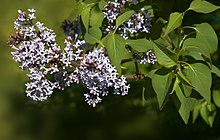
Syringa (lilac) is a genus of 12 currently recognized species of flowering woody plants in the olive family (Oleaceae), native to woodland and scrub from southeastern Europe to eastern Asia, and widely and commonly cultivated in temperate areas elsewhere.

Dimocarpus longan, commonly known as the longan, is a tropical tree species that produces edible fruit. It is one of the better-known tropical members of the soapberry family Sapindaceae, to which the lychee and rambutan also belong. The fruit of the longan is similar to that of the lychee, but less aromatic in taste. It is native to tropical Asia and China.

Mahonia is a genus of approximately 70 species of evergreen shrubs and rarely small trees in the family Berberidaceae, native to eastern Asia, the Himalaya, North and Central America. They are closely related to the genus Berberis and botanists disagree on whether to recognize a separate Mahonia. Many botanists prefer to classify Mahonia as a part of Berberis because several species in both genera are able to hybridize, and because there are no consistent morphological differences between the two groups other than the leaf pinnation. However, a recent DNA-based phylogenetic study retains the two separate genera, by clarifying that unifoliolate-leaved Berberis s.s. is derived from within a paraphyletic group of shrubs bearing imparipinnate evergreen leaves, which the paper then divides into three genera: Mahonia, Alloberberis, and Moranothamnus ; it confirms that a broadly-circumscribed Berberis is monophyletic.

Syringa vulgaris is a species of flowering plant in the olive family Oleaceae, native to the Balkan Peninsula, where it grows on rocky hills. Grown for its scented purple flowers in spring, this large shrub or small tree is widely cultivated and has been naturalized in parts of Europe and North America. It is not regarded as an aggressive species, found in the wild in widely scattered sites, usually in the vicinity of past or present human habitations.
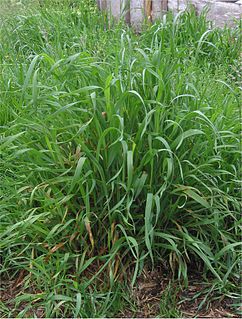
Elymus repens, commonly known as couch grass, is a very common perennial species of grass native to most of Europe, Asia, the Arctic biome, and northwest Africa. It has been brought into other mild northern climates for forage or erosion control, but is often considered a weed.

Chilopsis is a monotypic genus of flowering plants containing the single species Chilopsis linearis. It is known commonly as desert willow or desert-willow because of its willow-like leaves, but it is not a true willow – being instead a member of the catalpa family.

Acer ginnala, the Amur maple, is a plant species with woody stems native to northeastern Asia from easternmost Mongolia east to Korea and Japan, and north to the Russian Far East in the Amur River valley. It is a small maple with deciduous leaves that is sometimes grown as a garden subject or boulevard tree.

Syringa × laciniata, the cut-leaf lilac or cutleaf lilac, is a hybrid lilac of unknown, though old origin. It is thought to be a hybrid between Syringa vulgaris from southeastern Europe and Syringa protolaciniata from western China. Although often cited as being from China, it more likely arose somewhere in southwestern Asia, where it was first scientifically described from cultivated plants in the 17th century, possibly Iran or Afghanistan, or Pakistan, where it has been cultivated since ancient times.

Salix integra is a species of willow native to northeastern China, Japan, Korea and Primorsky Krai in the far southeast of Russia.

Syringa josikaea, the Hungarian lilac, is a species of lilac, native to central and eastern Europe, in the Carpathian Mountains in Hungary, Romania, and western Ukraine.
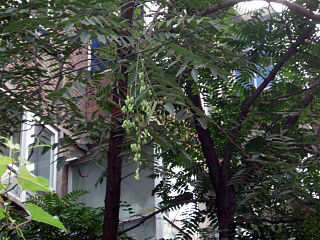
Toona sinensis, commonly called Chinese mahogany, Chinese cedar, Chinese toon, beef and onion plant, or red toon is a species of Toona native to eastern and southeastern Asia, from North Korea south through most of eastern, central and southwestern China to Nepal, northeastern India, Myanmar, Thailand, Malaysia, and western Indonesia.

Syringa reticulata, the Japanese tree lilac. is a species of flowering plant in the family Oleaceae native to eastern Asia, which is grown as an ornamental in Europe and North America.
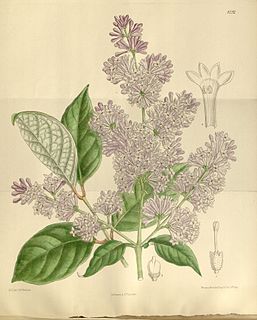
Syringa villosa, the villous lilac, is a shrub native to Korea, the southern part of the Russian Far East (Primorye) and northern China. There are two subspecies currently recognized ; these are regarded as separate species in Flora of China. Combining the ranges for the two taxa yields a range within China of Hebei, Shanxi, Heilongjiang, Jilin, and Liaoning.

Syringa pubescens is a species of flowering plant in the lilac genus of the family Oleaceae, native to Korea and China.
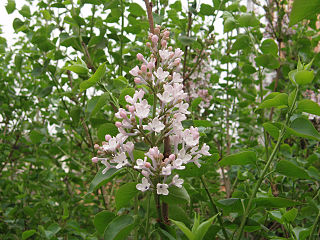
Syringa oblata is a species in the genus Syringa, in the family Oleaceae. It is also known as early blooming lilac or broadleaf lilac.

Syringa oblatasubsp.dilatata, also known as Korean early lilac, is a subspecies of the species Syringa oblata in the genus Syringa, in the family Oleaceae.

Syringa emodi is a species in the genus Syringa, in the family Oleaceae. It is also known as Himalayan lilac.
Syringa pinetorum is a species in the genus Syringa, in the family Oleaceae.

Syringa tomentella is a species in the genus Syringa, in the family Oleaceae.
Syringa reticulatasubsp.pekinensis, also known as the Pekin lilac or the Chinese tree lilac, grows in an open, multi-stemmed form to a height of 15 to 20 feet, with a spread of 10 to 15 feet. They are native to northern China but grow in USDA hardiness zones 3 through 7. It is grown as an ornamental tree in Europe and North America.
